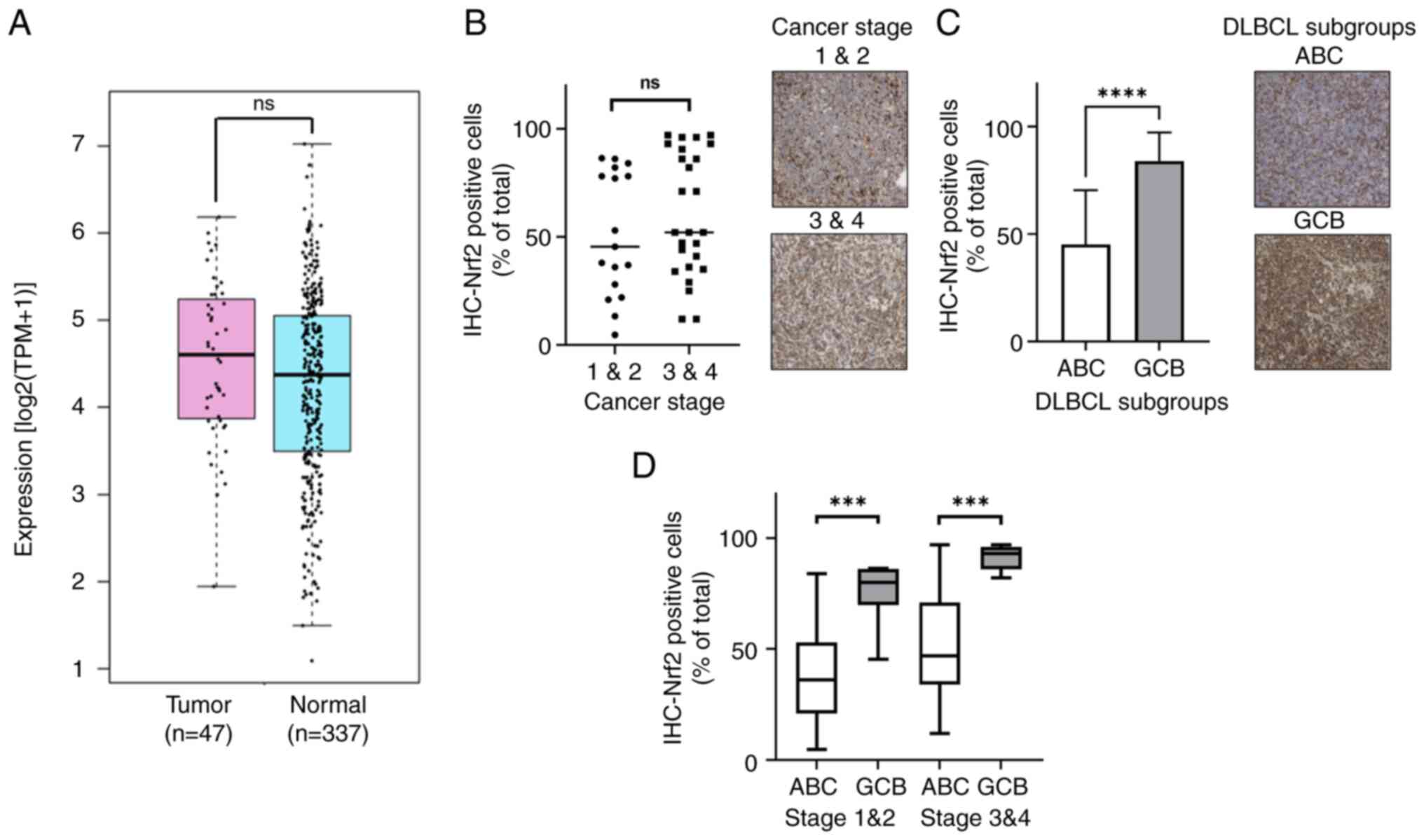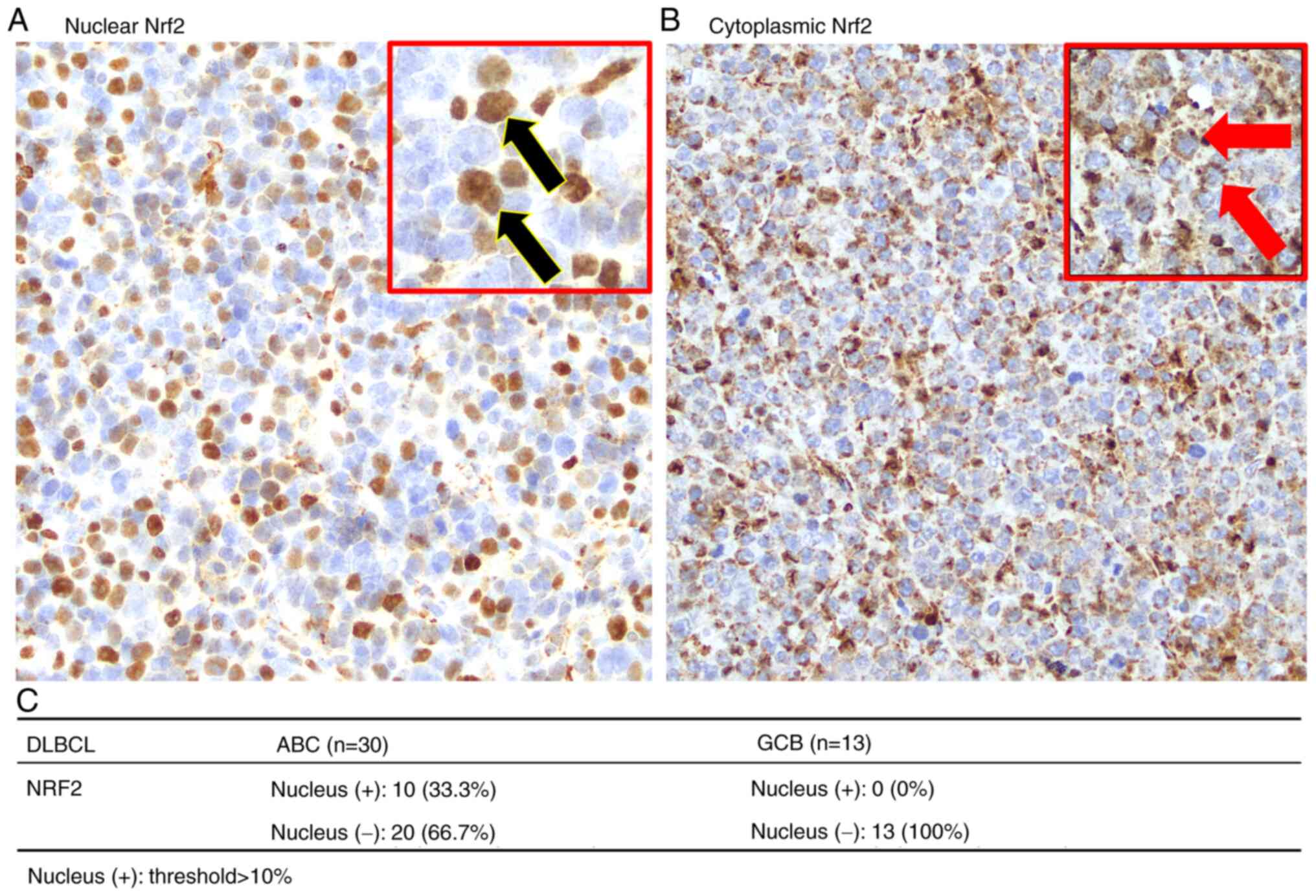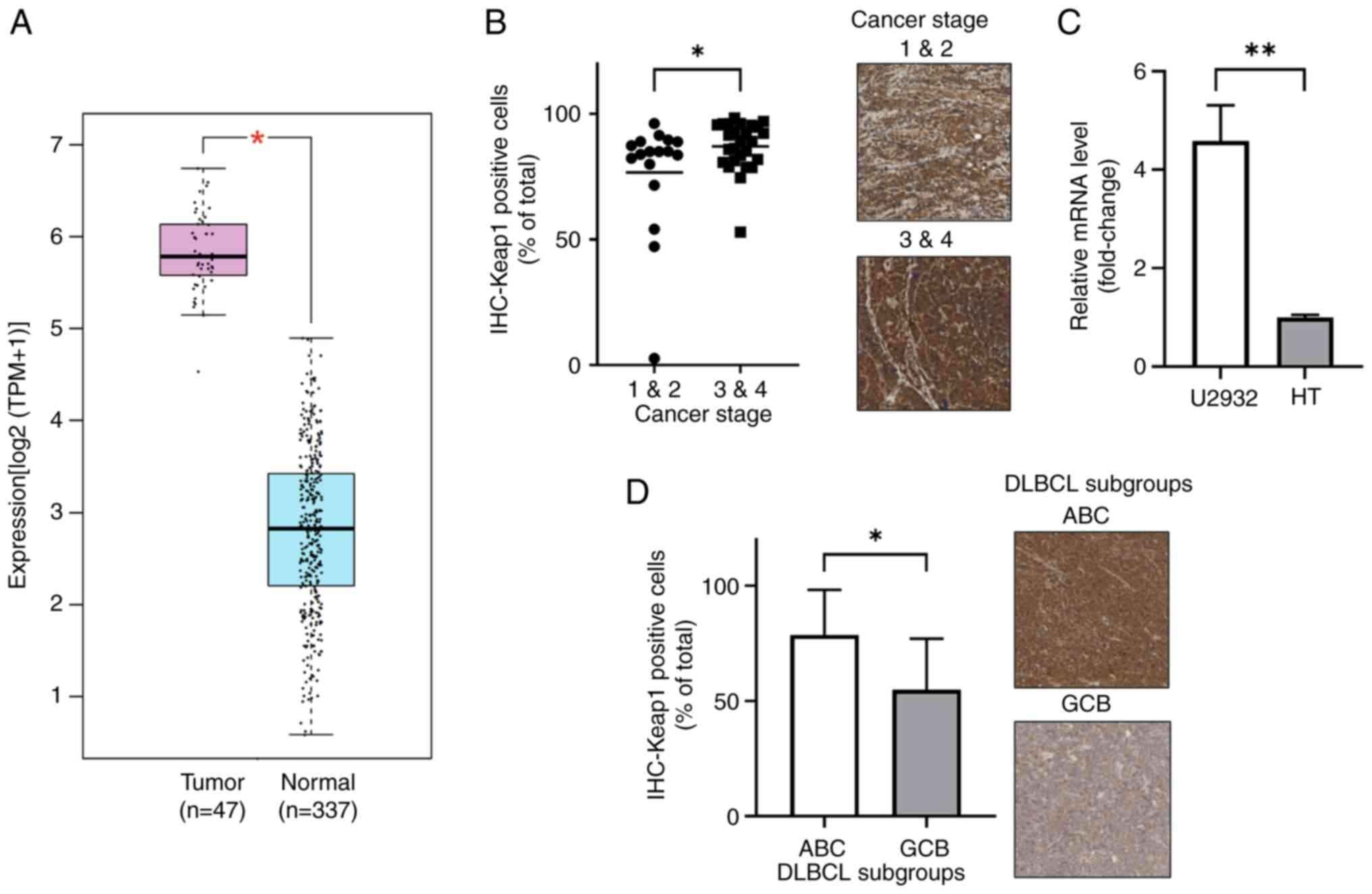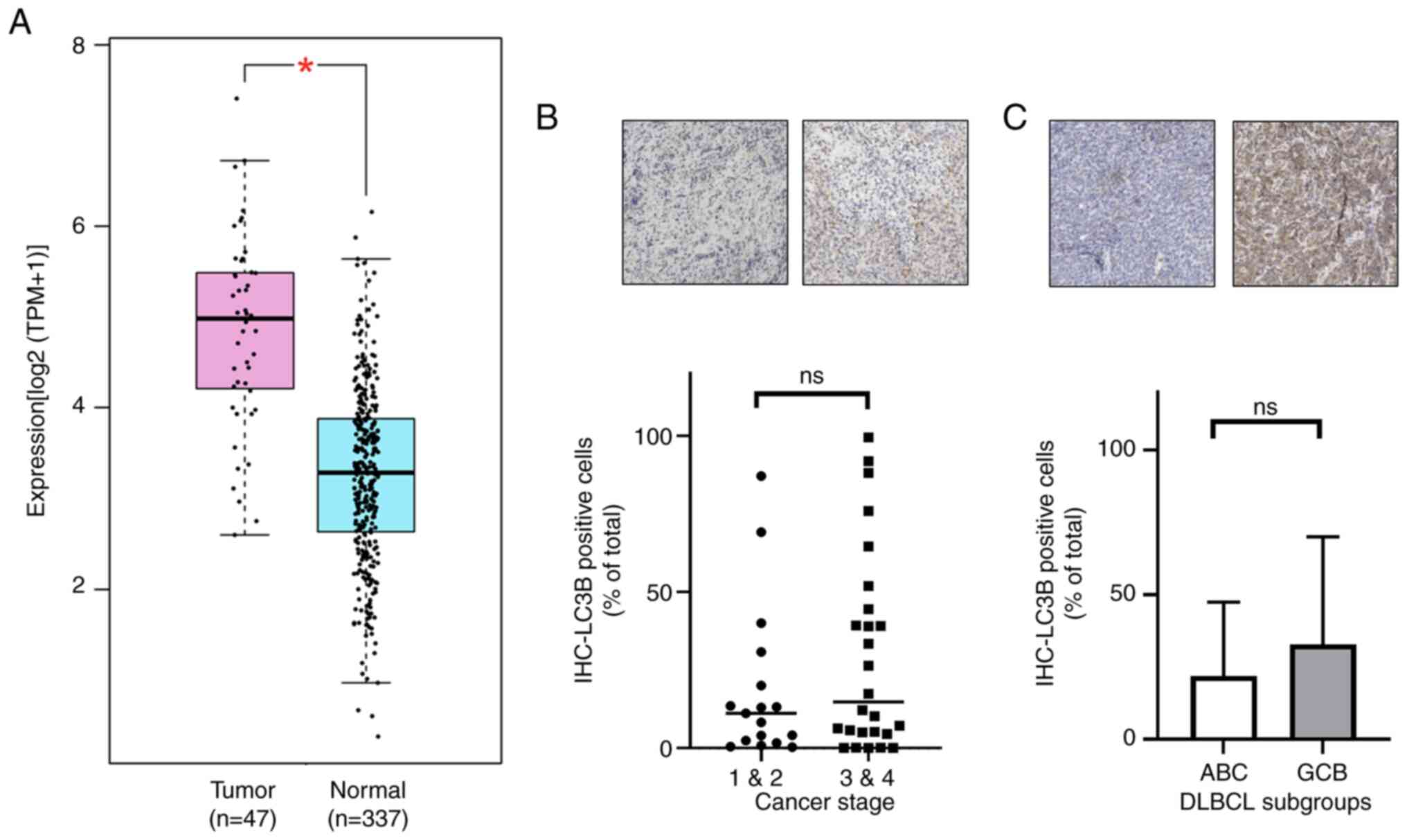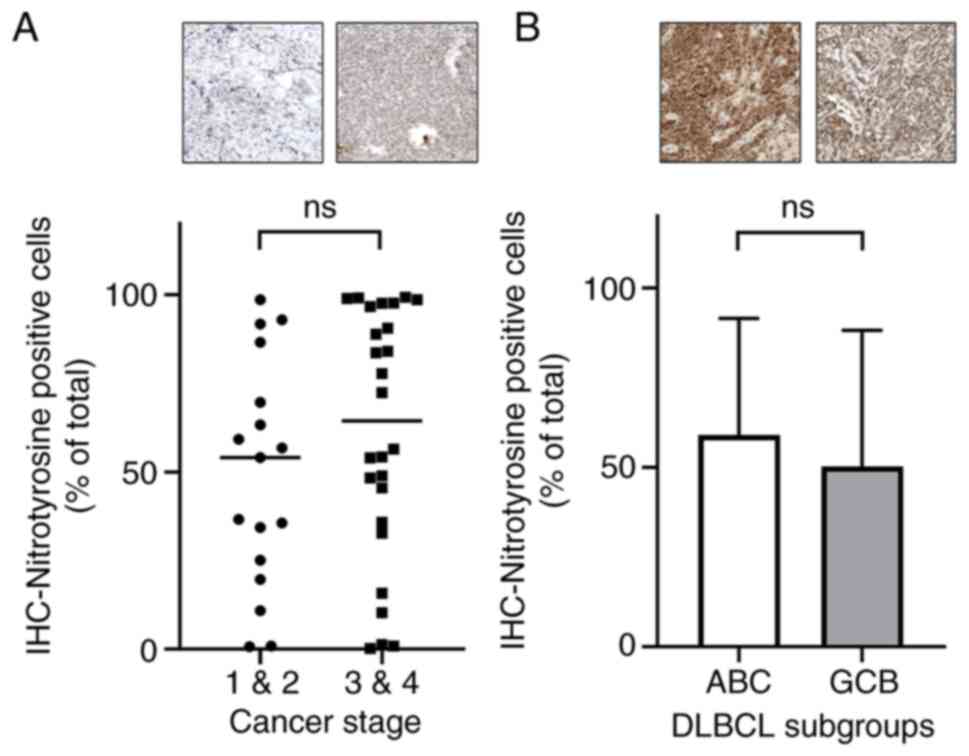|
1
|
Park C, Lee HS, Kang KW, Lee WS, Do YR,
Kwak JY, Shin HJ, Kim SY, Yi JH, Lim SN, et al: Combination of
acalabrutinib with lenalidomide and rituximab in
relapsed/refractory aggressive B-cell non-Hodgkin lymphoma: A
single-arm phase II trial. Nat Commun. 15:27762024. View Article : Google Scholar : PubMed/NCBI
|
|
2
|
Liu Y and Barta SK: Diffuse large B-cell
lymphoma: 2019 update on diagnosis, risk stratification, and
treatment. Am J Hematol. 94:604–616. 2019. View Article : Google Scholar : PubMed/NCBI
|
|
3
|
Silkenstedt E, Salles G, Campo E and
Dreyling M: B-cell non-Hodgkin lymphomas. Lancet; 2024, View Article : Google Scholar
|
|
4
|
Sehn LH and Salles G: Diffuse Large B-Cell
Lymphoma. N Engl J Med. 384:842–858. 2021. View Article : Google Scholar : PubMed/NCBI
|
|
5
|
Alaggio R, Amador C, Anagnostopoulos I,
Attygalle AD, Araujo IBO, Berti E, Bhagat G, Borges AM, Boyer D,
Calaminici M, et al: The 5th edition of the World Health
Organization Classification of Haematolymphoid Tumours: Lymphoid
Neoplasms. Leukemia. 36:1720–1748. 2022. View Article : Google Scholar : PubMed/NCBI
|
|
6
|
Eriksen PRG, de Groot F, Clasen-Linde E,
de Nully Brown P, de Groen R, Melchior LC, Maier AD, Minderman M,
Vermaat JSP, von Buchwald C, et al: Sinonasal DLBCL: Molecular
profiling identifies subtypes with distinctive prognosis and
targetable genetic features. Blood Adv. 8:1946–1957. 2024.
View Article : Google Scholar : PubMed/NCBI
|
|
7
|
Xia M, David L, Teater M, Gutierrez J,
Wang X, Meydan C, Lytle A, Slack GW, Scott DW, Morin RD, et al:
BCL10 mutations define distinct dependencies guiding precision
therapy for DLBCL. Cancer Discov. 12:1922–1941. 2022.PubMed/NCBI
|
|
8
|
Nowakowski GS, LaPlant B, Macon WR, Reeder
CB, Foran JM, Nelson GD, Thompson CA, Rivera CE, Inwards DJ,
Micallef IN, et al: Lenalidomide combined with R-CHOP overcomes
negative prognostic impact of Non-germinal center B-cell phenotype
in newly diagnosed diffuse Large B-Cell lymphoma: A phase II study.
J Clin Oncol. 33:251–257. 2015. View Article : Google Scholar : PubMed/NCBI
|
|
9
|
Lenz G, Hawkes E, Verhoef G, Haioun C,
Thye Lim S, Seog Heo D, Ardeshna K, Chong G, Haaber J, Shi W, et
al: Single-agent activity of phosphatidylinositol 3-kinase
inhibition with copanlisib in patients with molecularly defined
relapsed or refractory diffuse large B-cell lymphoma. Leukemia.
34:2184–2197. 2020. View Article : Google Scholar : PubMed/NCBI
|
|
10
|
Wilson WH, Young RM, Schmitz R, Yang Y,
Pittaluga S, Wright G, Lih CJ, Williams PM, Shaffer AL, Gerecitano
J, et al: Targeting B cell receptor signaling with ibrutinib in
diffuse large B cell lymphoma. Nat Med. 21:922–926. 2015.
View Article : Google Scholar : PubMed/NCBI
|
|
11
|
Wilson WH, Gerecitano JF, Goy A, de Vos S,
Kenkre VP, Barr PM, Blum KA, Shustov AR, Advani RH and Lih J: The
Bruton's tyrosine kinase (BTK) inhibitor, ibrutinib (PCI-32765),
has preferential activity in the ABC subtype of relapsed/refractory
de novo diffuse large B-cell lymphoma (DLBCL): Interim results of a
multicenter, open-label, phase 2 study. Blood. 120:6862012.
View Article : Google Scholar
|
|
12
|
Goy A, Ramchandren R, Ghosh N, Munoz J,
Morgan DS, Dang NH, Knapp M, Delioukina M, Kingsley E, Ping J, et
al: Ibrutinib plus lenalidomide and rituximab has promising
activity in relapsed/refractory non-germinal center B-cell-like
DLBCL. Blood. 134:1024–1036. 2019. View Article : Google Scholar : PubMed/NCBI
|
|
13
|
Czuczman MS, Trneny M, Davies A, Rule S,
Linton KM, Wagner-Johnston N, Gascoyne RD, Slack GW, Brousset P,
Eberhard DA, et al: A Phase 2/3 multicenter, randomized, open-label
study to compare the efficacy and safety of lenalidomide versus
Investigator's choice in patients with relapsed or refractory
diffuse large B-Cell lymphoma. Clin Cancer Res. 23:4127–4137. 2017.
View Article : Google Scholar : PubMed/NCBI
|
|
14
|
Kitamura H and Motohashi H: NRF2 addiction
in cancer cells. Cancer Sci. 109:900–911. 2018. View Article : Google Scholar : PubMed/NCBI
|
|
15
|
Gong Z, Xue L, Li H, Fan S, van Hasselt
CA, Li D, Zeng X, Tong MCF and Chen GG: Targeting Nrf2 to treat
thyroid cancer. Biomed Pharmacother. 173:1163242024. View Article : Google Scholar : PubMed/NCBI
|
|
16
|
Barrera-Rodriguez R: Importance of the
Keap1-Nrf2 pathway in NSCLC: Is It a possible biomarker? Biomed
Rep. 9:375–382. 2018.PubMed/NCBI
|
|
17
|
Liao H, Zhou Q, Zhang Z, Wang Q, Sun Y, Yi
X and Feng Y: NRF2 is overexpressed in ovarian epithelial carcinoma
and is regulated by gonadotrophin and sex-steroid hormones. Oncol
Rep. 27:1918–1924. 2012.PubMed/NCBI
|
|
18
|
Glorieux C, Enriquez C, Gonzalez C,
Aguirre-Martinez G and Buc Calderon P: The Multifaceted Roles of
NRF2 in Cancer: Friend or Foe? Antioxidants (Basel). 13:702024.
View Article : Google Scholar : PubMed/NCBI
|
|
19
|
Walker A, Singh A, Tully E, Woo J, Le A,
Nguyen T, Biswal S, Sharma D and Gabrielson E: Nrf2 signaling and
autophagy are complementary in protecting breast cancer cells
during glucose deprivation. Free Radic Biol Med. 120:407–413. 2018.
View Article : Google Scholar : PubMed/NCBI
|
|
20
|
Wang J, Liu Z, Hu T, Han L, Yu S, Yao Y,
Ruan Z, Tian T, Huang T, Wang M, et al: Nrf2 promotes progression
of non-small cell lung cancer through activating autophagy. Cell
Cycle. 16:1053–1062. 2017. View Article : Google Scholar : PubMed/NCBI
|
|
21
|
Jiang T, Harder B, Rojo de la Vega M, Wong
PK, Chapman E and Zhang DD: p62 links autophagy and Nrf2 signaling.
Free Radic Biol Med. 88:199–204. 2015. View Article : Google Scholar : PubMed/NCBI
|
|
22
|
Bartolini D, Dallaglio K, Torquato P,
Piroddi M and Galli F: Nrf2-p62 autophagy pathway and its response
to oxidative stress in hepatocellular carcinoma. Transl Res.
193:54–71. 2018. View Article : Google Scholar : PubMed/NCBI
|
|
23
|
Tang Z, Kang B, Li C, Chen T and Zhang Z:
GEPIA2: An enhanced web server for Large-scale expression profiling
and interactive analysis. Nucleic Acids Res. 47:W556–W560. 2019.
View Article : Google Scholar : PubMed/NCBI
|
|
24
|
Chandrashekar DS, Karthikeyan SK, Korla
PK, Patel H, Shovon AR, Athar M, Netto GJ, Qin ZS, Kumar S, Manne
U, et al: UALCAN: An update to the integrated cancer data analysis
platform. Neoplasia. 25:18–27. 2022. View Article : Google Scholar : PubMed/NCBI
|
|
25
|
Swerdlow SH, Campo E, Pileri SA, Harris
NL, Stein H, Siebert R, Advani R, Ghielmini M, Salles GA, Zelenetz
AD, et al: The 2016 revision of the World Health Organization
classification of lymphoid neoplasms. Blood. 127:2375–2390. 2016.
View Article : Google Scholar : PubMed/NCBI
|
|
26
|
Hsu CM, Chang KC, Chuang TM, Chu ML, Lin
PW, Liu HS, Kao SY, Liu YC, Huang CT, Wang MH, et al: High G9a
expression in DLBCL and its inhibition by niclosamide to induce
autophagy as a therapeutic approach. Cancers (Basel). 15:41502023.
View Article : Google Scholar : PubMed/NCBI
|
|
27
|
Hsu CM, Tsai Y, Wan L and Tsai FJ: Bufalin
induces G2/M phase arrest and triggers autophagy via the TNF, JNK,
BECN-1 and ATG8 pathway in human hepatoma cells. Int J Oncol.
43:338–348. 2013. View Article : Google Scholar : PubMed/NCBI
|
|
28
|
Livak KJ and Schmittgen TD: Analysis of
relative gene expression data using real-time quantitative PCR and
the 2(−Delta Delta C(T)) method. Methods. 25:402–408. 2001.
View Article : Google Scholar : PubMed/NCBI
|
|
29
|
Armitage JO: Staging non-Hodgkin lymphoma.
CA Cancer J Clin. 55:368–376. 2005. View Article : Google Scholar : PubMed/NCBI
|
|
30
|
Rojo de la Vega M, Chapman E and Zhang DD:
NRF2 and the hallmarks of cancer. Cancer Cell. 34:21–43. 2018.
View Article : Google Scholar : PubMed/NCBI
|
|
31
|
Komatsu M, Kurokawa H, Waguri S, Taguchi
K, Kobayashi A, Ichimura Y, Sou YS, Ueno I, Sakamoto A, Tong KI, et
al: The selective autophagy substrate p62 activates the stress
responsive transcription factor Nrf2 through inactivation of Keap1.
Nat Cell Biol. 12:213–223. 2010. View Article : Google Scholar : PubMed/NCBI
|
|
32
|
Zhang C, Ma S, Zhao X, Wen B, Sun P and Fu
Z: Upregulation of antioxidant and autophagy pathways via NRF2
activation protects spinal cord neurons from ozone damage. Mol Med
Rep. 23:4282021. View Article : Google Scholar : PubMed/NCBI
|
|
33
|
Azam F, Latif MF, Farooq A, Tirmazy SH,
AlShahrani S, Bashir S and Bukhari N: Performance status assessment
by using ECOG (Eastern Cooperative Oncology Group) score for cancer
patients by oncology healthcare professionals. Case Rep Oncol.
12:728–736. 2019. View Article : Google Scholar : PubMed/NCBI
|
|
34
|
Wang SS: Epidemiology and etiology of
diffuse large B-cell lymphoma. Semin Hematol. 60:255–266. 2023.
View Article : Google Scholar : PubMed/NCBI
|
|
35
|
Alizadeh AA, Eisen MB, Davis RE, Ma C,
Lossos IS, Rosenwald A, Boldrick JC, Sabet H, Tran T, Yu X, et al:
Distinct types of diffuse large B-cell lymphoma identified by gene
expression profiling. Nature. 403:503–511. 2000. View Article : Google Scholar : PubMed/NCBI
|
|
36
|
Nowakowski GS, Chiappella A, Witzig TE,
Scott DW, Spina M, Gascoyne RD, Zhang L, Russo J, Kang J, Zhang J,
et al: Variable global distribution of cell-of-origin from the
ROBUST phase III study in diffuse large B-cell lymphoma.
Haematologica. 105:e72–e75. 2020. View Article : Google Scholar : PubMed/NCBI
|
|
37
|
Shiozawa E, Yamochi-Onizuka T, Takimoto M
and Ota H: The GCB subtype of diffuse large B-cell lymphoma is less
frequent in Asian countries. Leuk Res. 31:1579–1583. 2007.
View Article : Google Scholar : PubMed/NCBI
|
|
38
|
Pileri SA, Tripodo C, Melle F, Motta G,
Tabanelli V, Fiori S, Vegliante MC, Mazzara S, Ciavarella S and
Derenzini E: Predictive and prognostic molecular factors in diffuse
large B-Cell Lymphomas. Cells. 10:2021. View Article : Google Scholar
|
|
39
|
Wang XJ, Sun Z, Villeneuve NF, Zhang S,
Zhao F, Li Y, Chen W, Yi X, Zheng W, Wondrak GT, et al: Nrf2
enhances resistance of cancer cells to chemotherapeutic drugs, the
dark side of Nrf2. Carcinogenesis. 29:1235–1243. 2008. View Article : Google Scholar : PubMed/NCBI
|
|
40
|
Yen CH and Hsiao HH: NRF2 is one of the
players involved in bone marrow mediated drug resistance in
multiple myeloma. Int J Mol Sci. 19:35032018. View Article : Google Scholar : PubMed/NCBI
|
|
41
|
Yi X, Zhao Y, Xue L, Zhang J, Qiao Y, Jin
Q and Li H: Expression of Keap1 and Nrf2 in diffuse large B-cell
lymphoma and its clinical significance. Exp Ther Med. 16:573–578.
2018.PubMed/NCBI
|
|
42
|
Schaedler S, Krause J, Himmelsbach K,
Carvajal-Yepes M, Lieder F, Klingel K, Nassal M, Weiss TS, Werner S
and Hildt E: Hepatitis B virus induces expression of antioxidant
response element-regulated genes by activation of Nrf2. J Biol
Chem. 285:41074–41086. 2010. View Article : Google Scholar : PubMed/NCBI
|
|
43
|
Severi T, Vander Borght S, Libbrecht L,
VanAelst L, Nevens F, Roskams T, Cassiman D, Fevery J, Verslype C
and van Pelt JF: HBx or HCV core gene expression in HepG2 human
liver cells results in a survival benefit against oxidative stress
with possible implications for HCC development. Chem Biol Interact.
168:128–134. 2007. View Article : Google Scholar : PubMed/NCBI
|
|
44
|
Basic M, Thiyagarajah K, Glitscher M,
Schollmeier A, Wu Q, Gorgulu E, Lembeck P, Sonnenberg J, Dietz J,
Finkelmeier F, et al: Impaired HBsAg release and
antiproliferative/antioxidant cell regulation by HBeAg-negative
patient isolates reflects an evolutionary process. Liver Int.
44:2773–2792. 2024. View Article : Google Scholar : PubMed/NCBI
|
|
45
|
Peiffer KH, Akhras S, Himmelsbach K,
Hassemer M, Finkernagel M, Carra G, Nuebling M, Chudy M, Niekamp H,
Glebe D, et al: Intracellular accumulation of subviral HBsAg
particles and diminished Nrf2 activation in HBV genotype G
expressing cells lead to an increased ROI level. J Hepatol.
62:791–798. 2015. View Article : Google Scholar : PubMed/NCBI
|
|
46
|
Kalantari L, Ghotbabadi ZR, Gholipour A,
Ehymayed HM, Najafiyan B, Amirlou P, Yasamineh S, Gholizadeh O and
Emtiazi N: A state-of-the-art review on the NRF2 in Hepatitis
virus-associated liver cancer. Cell Commun Signal. 21:3182023.
View Article : Google Scholar : PubMed/NCBI
|
|
47
|
Ariffianto A, Deng L, Abe T, Matsui C, Ito
M, Ryo A, Aly HH, Watashi K, Suzuki T, Mizokami M, et al: Oxidative
stress sensor Keap1 recognizes HBx protein to activate the Nrf2/ARE
signaling pathway, thereby inhibiting hepatitis B virus
replication. J Virol. 97:e01287232023. View Article : Google Scholar : PubMed/NCBI
|
|
48
|
Bender D and Hildt E: Effect of hepatitis
viruses on the Nrf2/Keap1-signaling pathway and its impact on viral
replication and pathogenesis. Int J Mol Sci. 20:46592019.
View Article : Google Scholar : PubMed/NCBI
|
|
49
|
Uruno A, Furusawa Y, Yagishita Y, Fukutomi
T, Muramatsu H, Negishi T, Sugawara A, Kensler TW and Yamamoto M:
The Keap1-Nrf2 system prevents onset of diabetes mellitus. Mol Cell
Biol. 33:2996–3010. 2013. View Article : Google Scholar : PubMed/NCBI
|
|
50
|
Shin S, Wakabayashi J, Yates MS,
Wakabayashi N, Dolan PM, Aja S, Liby KT, Sporn MB, Yamamoto M and
Kensler TW: Role of Nrf2 in prevention of high-fat diet-induced
obesity by synthetic triterpenoid CDDO-imidazolide. Eur J
Pharmacol. 620:138–144. 2009. View Article : Google Scholar : PubMed/NCBI
|
|
51
|
Baumel-Alterzon S, Katz LS, Brill G,
Garcia-Ocana A and Scott DK: Nrf2: The master and captain of beta
cell fate. Trends Endocrinol Metab. 32:7–19. 2021. View Article : Google Scholar : PubMed/NCBI
|
|
52
|
David JA, Rifkin WJ, Rabbani PS and
Ceradini DJ: The Nrf2/Keap1/ARE pathway and oxidative stress as a
therapeutic target in type II diabetes mellitus. J Diabetes Res.
2017:48267242017. View Article : Google Scholar : PubMed/NCBI
|
|
53
|
Baird L and Yamamoto M: The molecular
mechanisms regulating the KEAP1-NRF2 Pathway. Mol Cell Biol.
40:e00099–20. 2020. View Article : Google Scholar : PubMed/NCBI
|
|
54
|
Mai Y, Yu JJ, Bartholdy B, Xu-Monette ZY,
Knapp EE, Yuan F, Chen H, Ding BB, Yao Z, Das B, et al: An
oxidative stress-based mechanism of doxorubicin cytotoxicity
suggests new therapeutic strategies in ABC-DLBCL. Blood.
128:2797–2807. 2016. View Article : Google Scholar : PubMed/NCBI
|
|
55
|
Zavitsanou AM, Pillai R, Hao Y, Wu WL,
Bartnicki E, Karakousi T, Rajalingam S, Herrera A, Karatza A,
Rashidfarrokhi A, et al: KEAP1 mutation in lung adenocarcinoma
promotes immune evasion and immunotherapy resistance. Cell Rep.
42:1132952023. View Article : Google Scholar : PubMed/NCBI
|
|
56
|
Shibata T, Ohta T, Tong KI, Kokubu A,
Odogawa R, Tsuta K, Asamura H, Yamamoto M and Hirohashi S: Cancer
related mutations in NRF2 impair its recognition by Keap1-Cul3 E3
ligase and promote malignancy. Proc Natl Acad Sci USA.
105:13568–13573. 2008. View Article : Google Scholar : PubMed/NCBI
|
|
57
|
Mandhair HK, Radpour R, Westerhuis M, Banz
Y, Humbert M, Arambasic M, Dengjel J, Davies A, Tschan MP and Novak
U: Analysis of autophagy in DLBCL reveals subtype-specific
differences and the preferential targeting of ULK1 inhibition in
GCB-DLBCL provides a rationale as a new therapeutic approach.
Leukemia. 38:424–429. 2024. View Article : Google Scholar : PubMed/NCBI
|
|
58
|
Galluzzi L, Pietrocola F, Bravo-San Pedro
JM, Amaravadi RK, Baehrecke EH, Cecconi F, Codogno P, Debnath J,
Gewirtz DA, Karantza V, et al: Autophagy in malignant
transformation and cancer progression. EMBO J. 34:856–880. 2015.
View Article : Google Scholar : PubMed/NCBI
|
|
59
|
Cadenas-Garrido P, Schonvandt-Alarcos A,
Herrera-Quintana L, Vazquez-Lorente H, Santamaria-Quiles A, Ruiz de
Francisco J, Moya-Escudero M, Martin-Oliva D, Martin-Guerrero SM,
Rodriguez-Santana C, et al: Using redox proteomics to gain new
insights into neurodegenerative disease and protein modification.
Antioxidants (Basel). 13:1272024. View Article : Google Scholar : PubMed/NCBI
|



